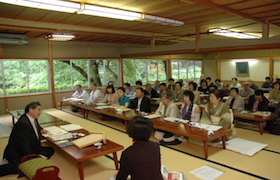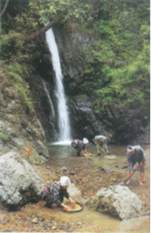Yasunari Kawabata’s birthday month: June <3>
 Kyoto, the love story of Kawabata YasunariOpening lecture 2008 Lecturer: Professor Kawabata Kaori Kyoto, the love story of Kawabata YasunariOpening lecture 2008 Lecturer: Professor Kawabata Kaori Chairman of the Kawabata Yasunari Memorial Foundation Professor Emeritus, University of Tokyo |
 Bodai Falls |
Yoshie Doi
I am writing a series of blogs in honor of Yasunari Kawabata’s birth month. There are still many landscapes in Kyoto that were engraved in Yasunari’s heart. Kyoto City is a basin surrounded by mountains on three sides, and we live looking at the mountains every day, 365 days of the year. Perhaps it is because of this environment that we are sensitive to the colors of the mountains and the colors of nature.
In 2008, Professor Kawabata Kaoru gave a lecture entitled “The Kyoto that Kawabata Yasunari Beloved” as the opening course for Kyo Suzume School’s “Kyoto Love Stories” curriculum.
He married Yasunari Kawabata’s adopted daughter, Masako, and joined the Kawabata family. He was with Yasunari even before he won the Nobel Prize, and was able to ask about Yasunari’s feelings for Kyoto. Unfortunately, Professor Kaori Kawabata passed away on February 3, 2021, at the age of 87, and we would like to express our deepest condolences.
Professor Kaori has traveled from Kamakura to Kyoto many times and has taught me many things. I remember our conversation while walking around Togetsukyo Bridge as a pleasant memory, as if it were yesterday. At that time, I asked him about his lecture in French in Paris and about his own health management methods.
As the chairman of the judging committee for the “Love Letter to Kyoto” public competition, which was born from the “Kyoto Love Stories” curriculum, he visited Kyoto many times and each time shared with us Professor Yasunari’s thoughts.
Perhaps it was Kyoto’s deep love for nature, culture and history that gave birth to the “Ancient Capital.” In the preface to “Kyoto Four Seasons,” entitled “The Shape of the Capital – A Final Thought,” Higashiyama Kaii wrote when he released his series “Kyoto Four Seasons,” “As he walked through the streets of Kyoto, he kept muttering to himself, “I can’t see the mountains, I can’t see the mountains.”Ugly cheap Western-style buildings began to go up one after the other, and the mountains could no longer be seen from the town streets,” wrote Higashiyama Kaii when he published his “Kyoto Four Seasons” series.
There are many sharp observations about nature in “Koto : The Ancient Capital,” especially the bodhi sand of Kitayama Cedar in the Nakagawa area of Kitayama.
Six hundred years ago, a high priest who had been training in the mountains all over the country collapsed in a village in what is now the Kitayama Nakagawa district of Kita Ward in Kyoto City. He made a full recovery after about six months of tireless nursing by the villagers.
A story passed down among the villagers said, “Thank you for showing us such kindness for so many years, even though Nakagawa village cannot produce rice. I would like to show you something in return, but I have nothing to give you, so I cannot show you anything in return. Instead, I will teach you something good. The sand from Bodai Falls in this village has a rare power that cannot be found anywhere else. If you use this sand to polish this cedar log, I am sure that the village will prosper.
The sand that falls into the pool at the bottom of the waterfall from rain that falls on Mount Akasuna behind the falls (Bodai Falls) is called Masagoko sand, which is weathered granite. The high priest felt that there was something powerful about the sand, not just the soil, so he named it “Bodai Falls.”
In the 20th century, analysis of the sand from the Kitayama Maruta (polished logs) at Bodai Falls revealed the presence of a geological layer containing elements essential for making semiconductor .
The area around Bodai Falls, where the sand used to finish Kitayama Maruta (cedar logs) is collected, is a power spot today. The sand contains Zr (40 zirconium), a layer of SiO2 (quartz), and deposits containing Si (14 silicon) and SiC (silicon carbide) have been discovered. In addition to being used as abrasives, polishing agents, and whetstones, these substances are also used to make silicon wafers, the semiconductor that are in the spotlight in 21st century science and technology, and devices that use silicon wafers are used in some way in everything around us today. As for SiC, they are SiC wafers for power devices that are sparking an energy revolution. It is easy to see why this area was once an excavation site for abrasive powder.
I heard from the Nakagawa area that many people have been visiting Bodai Falls from all over the world this year, including visitors from France, Africa, Tunisia, Canada, Russia, Italy, Dubai and Australia. Although the stairs leading down to Bodai Falls were destroyed by flooding, so visitors have to take a detour, many of them still visit.
I sincerely hope that the area will be developed into a place worthy of being one of Kyoto’s super spots. (Continued)
The end of document
Translated by Masami Otani
